- By Dan Veaner
- News
 Print
Print 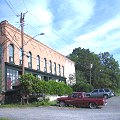 Ludlowville residents know that the Lansing hamlet might better be called Floodlowville. The bowl-like community in the crook of Salmon Creek is the receiving end of continual flooding that has apparently been caused by historical bad drainage decisions, erosion, and has caused a recorded $315,000 of damage between 1991 and 2005 alone.
Ludlowville residents know that the Lansing hamlet might better be called Floodlowville. The bowl-like community in the crook of Salmon Creek is the receiving end of continual flooding that has apparently been caused by historical bad drainage decisions, erosion, and has caused a recorded $315,000 of damage between 1991 and 2005 alone.About 15 Ludlowville residents crammed into the small courtroom at Lansing Town Hall earlier this month for the second public meeting about a project that is designed to reduce damaging flooding in the hamlet. Tompkins County Senior Planner Scott Doyle called the meeting to tell residents what progress has been made since they first met last August. Barton & Loguidice Charles White, David Hanny, and Scott Nostrand were on hand to present their technical findings on the causes of the floods.
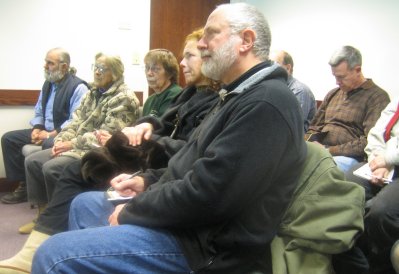
Doyle told residents that their continued partnership with engineers working on the project have been invaluable. "The walks that we have done with you already have been extremely helpful," he said. "I'm sure there is a lot more that we can gather by continuing to partner and work together as we have so far."
The $480,000 project is intended to help to avoid future damage by studying where the water is coming from and devising solutions. Half of the money comes from the Department of Environmental Conservation's (DEC) Water Quality Improvement Project funding, while the other half is matched locally by Town of Lansing and Tompkins County County equipment and labor to implement the project.
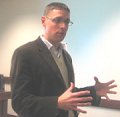 | 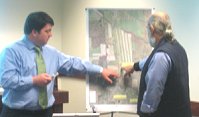 |
| Scott Doyle (left) A resident shows White a spot just beyond the project scope area that he says is a major problem spot | |
Doyle handed out the address of a new Web site dedicated to the project. The site includes presentations, results of studies, and information about the project that he pledged to update regularly.
White and Hanny told residents that the geographic scope of the project had widened significantly in their efforts to trace the sources of the water and the paths it now takes. Since the meeting last summer engineers have walked the area to try to understand where problem spots are. Meanwhile Doyle has gathered information from a survey he distributed to residents to gather historical data on past construction projects that may have diverted the water and specifics about flooding events. The questionnaire asked for documentation and photographs of flood damage and detailed information about individual floods, and this data figured into the technical report that was presented.
"It is critical that before we talk about solutions we need to get a clear analysis of loss history and damages," he said.
As engineers presented their findings residents were invited to ask questions, or to correct or amend things they might have missed. White said he expects resident input to continue to help drive the project. The next step will be to come up with alternative solutions for Town and County officials to select from.
"As the engineers select the preferred alternatives are -- those are selected by the project sponsors, the County and the Town," he said. "I would expect that would come with a lot of weighted input from you residents. Once mitigation alternatives have been selected the next step of the project is to design and implement them."
Ludlowville resident Dave Taylor asked whether the state money could be jeopardized by the current economic crisis. "No, this is something that we locked up," Doyle replied. "I had the same concern and I called talk about this issue. They said moving forward there is concern for future projects, but this is one that has already been earmarked. I think there is a great case based on the information that's been built for future work, especially with this solid front-end work."
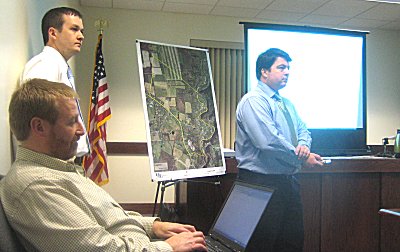
Barton & Loguidice Charles White (right), David Hanny (standing left),
and Scott Nostrand (foreground)
Doyle promised to keep residents in the loop as the project goes forward. White said the timetable calls for a second technical report with recommendations for stormwater controls in Spring, and a third report that will include designs for the preferred alternative plans by late summer. He said construction would take place in phases through 2009 and 2010.
"Ultimately I foresee phased construction," he said. "I don't think this is all going to be one huge operation. There are opportunities for both the County and the Town to implement improvements using their own labor forces and equipment. At this point it is hard to say how much and what will be done by whom. But we expect construction to begin in late '09, and for it to be in full swing throughout 2010."
----
v5i4



